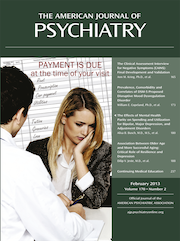Two billion persons over age 60 will live in the world by 2050. This population explosion of older persons has led to increased interest in also lengthening the healthspan—defined not only as longevity but also as the maintenance of general health, vigor, and quality of life with aging (
1). A 1987 landmark article in
Science by Rowe and Kahn (
2) addressed the need to consider multifaceted aspects of health in aging, rather than focus solely on “diseased” versus “nondiseased” status. They delineated the primary components of healthy aging: lack of chronic disease, maintenance of physical and cognitive function, and engagement in social and productive activities.
Most research, however, continues to emphasize only one or two of these components. For example, Depp and Jeste (
3) reviewed 29 studies of predictors of healthy aging; no single component within the Rowe and Kahn outline was common across all studies. The large majority included physical function (26 of the studies), but different subsets addressed each of the other components (e.g., 13 included cognitive function, nine included mental health and well-being, eight included social engagement, and six included chronic illnesses). There is no doubt that physical function is important in aging, and it is receiving growing attention in the aging literature. Physical syndromes, such as “frailty,” are being rigorously defined (
4), and standardized objective measures of function (e.g., the Short Physical Performance Battery [
5]) are increasingly used by researchers interested in determining how physical health can be maintained with aging. But this attention to evaluating objective measures of health is not necessarily the only approach to improving the “healthspan.” Indeed, initial research indicates that older persons’ level of physical health or function is not in fact well correlated with their own perception of their “successful aging” (
6,
7). This suggests that additional focus on understanding contributors to self-perceived health in aging could potentially yield improved quality of life in older persons.
In this issue of the
Journal, Jeste et al. (
8) describe one of the first large-scale community-based studies devoted to evaluating determinants and correlates of self-rated successful aging. The Successful AGing Evaluation (SAGE) study assessed a cohort of 1,006 community-dwelling adults, ages 50–99, in San Diego County with a combination of telephone and mail surveys of physical, cognitive, and psychological domains, including self-rated successful aging. Jeste et al. report several important initial findings from SAGE. Self-rated successful aging steadily increases rather than declines from age 50 to age 99 years. Across increasing age cohorts within SAGE, a greater proportion of persons felt they had aged successfully. This increase in self-satisfaction is noteworthy because SAGE also found the expected concomitant decrease in physical and cognitive function performance, as well as in subjective cognitive functioning, with aging.
The authors followed up this initial finding with an examination of factors that might be related to self-rated successful aging. Among a variety of factors examined, mental health appeared to be key. Greater resilience (as determined by the Connor-Davidson Resilience Scale [
9]) and less depression were among the strongest variables associated with self-rated successful aging.
A strength of the study is its large sample size, in which the oldest age groups (80–99 years) were oversampled. There was adequate statistical power to evaluate factors related to aging even in the “oldest-old”; in contrast, much existing research on aging includes smaller numbers of the oldest adults and has more limited ability to conduct analyses across a wide span of older ages. Moreover, participation was high in the older age groups (e.g., 84% participation among those 80–89 years old), helping to ensure the validity of results. Low participation rates in older persons can lead to overrepresentation of the healthiest individuals, since those who participate are usually healthier than those who do not. There are important limitations of the study, which are recognized appropriately by the authors. The most critical limitation is the current availability of only cross-sectional data. Thus, the observation that self-rated successful aging becomes more common with age is based on findings at a single point in time across distinct age cohorts in SAGE, rather than findings over time in a specific aging person. This leads to the possibility of cohort or survivor effects; for example, the subset of the population that survives to the oldest ages may represent a selectively healthy cohort.
In cross-sectional data, temporality is impossible to establish; one could as easily imagine that worse self-rated successful aging leads to greater depression as that greater depression leads to worse self-rated successful aging. Until the SAGE study has prospective data to directly evaluate change in self-rated successful aging in individuals over time, as well as determinants of change in self-rated successful aging, the findings from this study do not yet have broad public health relevance, as the authors themselves note.
Jeste et al.’s findings place greater significance on subjective perception rather than objective physical measures and may lead to new insights on how to preserve and improve well-being in our rapidly aging population. Prospective investigations from the SAGE study may identify factors involved in self-rated successful aging and should motivate heightened interest in the examination of this issue by other aging studies.

